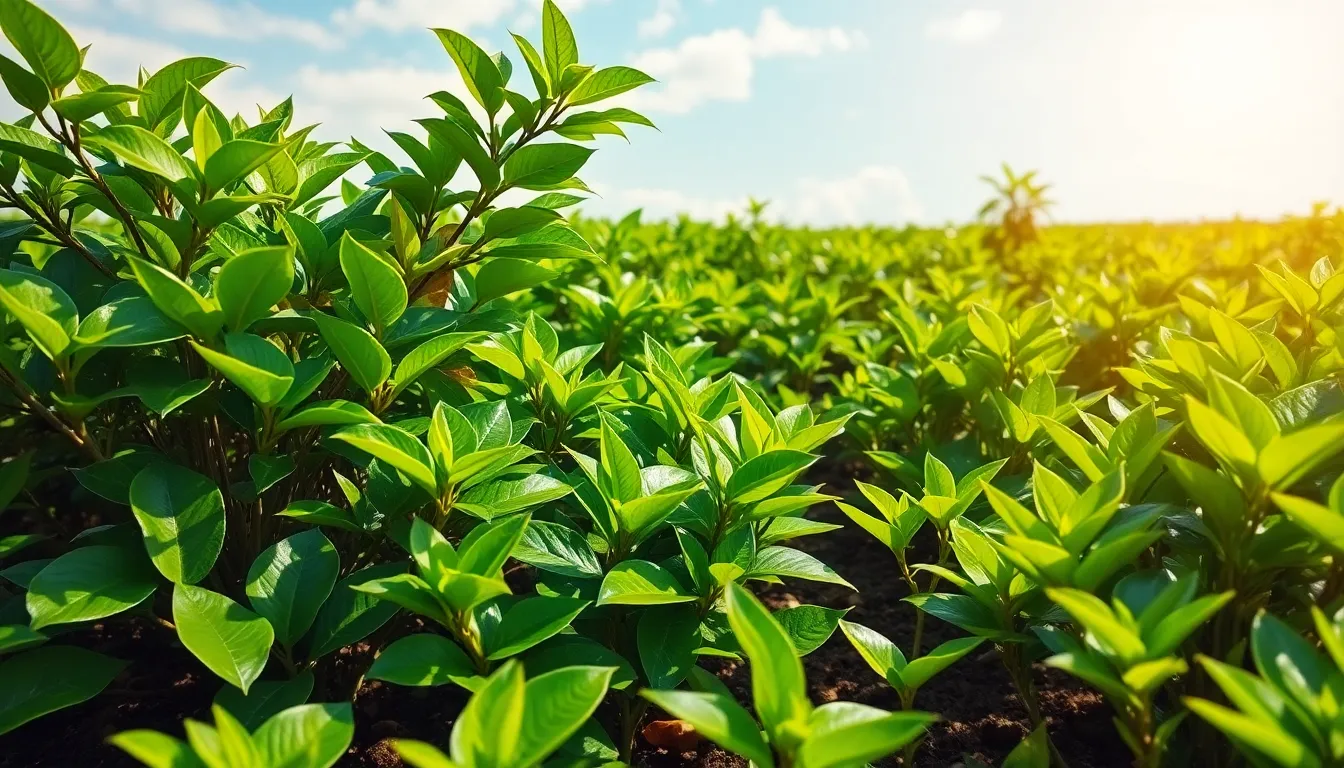Imagine sipping a cup of freshly brewed tea made from leaves plucked right from your own garden. Sounds like a dream, right? With a little love and the right care, that dream can become a reality. Tea plants aren’t just for the pros; anyone can cultivate these beauties at home.
Tea Plant Care
Caring for tea plants requires attention to various factors that promote healthy growth. Light plays a crucial role; tea plants thrive in bright, indirect sunlight. A location that receives several hours of indirect light daily enhances their development.
Soil quality is another important consideration. Use well-draining soil mixed with organic compost. This mixture supports healthy root systems and nutrient uptake.
Watering is essential for tea plants. Keep the soil consistently moist but not waterlogged. Under-watering contributes to stress, while over-watering leads to root rot. Checking the top inch of soil can indicate when it’s time to water.
Fertilization supports robust growth. Applying a balanced fertilizer every four to six weeks during the growing season fosters strong leaves. Select fertilizers with nitrogen, phosphorus, and potassium to support overall plant health.
Pruning promotes bushier growth. Remove dead or damaged leaves regularly to encourage new growth. Timing can depend on local climate conditions but generally occurs in early spring. The process helps maintain a healthy structure and boosts leaf production.
Pest management is necessary for maintaining plant health. Common pests like aphids and spider mites can affect tea plants. Regular inspections and the use of neem oil as an organic pesticide can effectively control infestations.
Lastly, understanding specific tea plant varieties aids in proper care. Varieties like Camellia sinensis and Camellia assamica exhibit different growth patterns and requirements. Familiarizing with the chosen type allows for tailored care, enhancing growth and quality of the tea leaves produced.
Choosing the Right Tea Plant

Selecting the right tea plant is fundamental for successful cultivation. Different varieties offer unique flavors and growth requirements.
Popular Varieties
Camellia sinensis represents the most commonly cultivated tea plant, known for producing green, black, and white tea. Many enthusiasts enjoy Camellia assamica, which delivers a robust flavor favored in Assam teas. Other notable varieties include Camellia sinensis var. pubiloba, recognized for its fragrant leaves, and Camellia japonica, occasionally grown for ornamental purposes. Choosing a variety that aligns with desired tea characteristics enhances the overall gardening experience.
Climate Considerations
Tea plants thrive best in subtropical and tropical climates. Ideal temperatures range from 60 to 80°F, ensuring optimal growth. They require an average annual rainfall of 40 to 100 inches, preferably distributed evenly throughout the year. Locations with mild winters can support year-round growth, but prolonged frost can damage plants. Additionally, humidity levels of 60 to 80% promote healthy leaf development. Researching local climate conditions aids in selecting the most suitable tea plant variety for specific environments.
Essential Care Tips for Tea Plants
Proper care for tea plants ensures healthy growth and optimal leaf quality. Follow these essential tips for best results.
Soil Requirements
Choose well-draining soil mixed with organic compost for tea plants. The soil should retain moisture while allowing excess water to escape. A pH level between 5.0 and 6.5 is ideal. Heavy or compacted soils can lead to root rot, so avoid them. Enriching the soil with nutrients promotes healthy development, and incorporating perlite or sand can enhance drainage. Regularly check soil conditions to maintain optimal quality.
Watering Techniques
Consistent watering maintains tea plant health. Water the plants deeply but infrequently to encourage strong root growth. It’s crucial to allow the top inch of soil to dry out between waterings. Over-saturation can result in root rot, which threatens plant vitality. Adjust watering frequency based on climate conditions and plant growth stages. Using rainwater or distilled water helps avoid chemical buildups from tap water.
Fertilization Guidelines
Regular fertilization supports robust tea plants. A balanced fertilizer, rich in nitrogen and potassium, promotes growth and leaf development. Fertilize every four to six weeks during the growing season, typically spring to summer. Organic options like fish emulsion or compost tea work well. Monitor plant response to fertilization; adjust the formula if growth becomes stagnant. Avoid over-fertilizing, as this can harm delicate tea plants.
Common Pests and Diseases
Tea plants can encounter several pests and diseases that affect their health and leaf quality. Monitoring for these threats ensures plants thrive in their environment.
Prevention Strategies
Maintaining plant health through proper care deters pests and diseases. Ensuring good air circulation around tea plants helps minimize fungal infections. Employing companion planting with herbs like basil and mint repels harmful insects. Additionally, regular inspections for early signs of infestation support prompt action. Choosing disease-resistant varieties aids in preventing future issues. Lastly, keeping the garden area clean reduces potential pest habitats.
Treatment Options
Addressing pest infestations often requires multiple approaches. Introducing beneficial insects, such as ladybugs and lacewings, naturally controls aphid populations. Insecticidal soaps or neem oil can effectively target pests while remaining plant-friendly. For fungal issues, fungicides provide a targeted treatment for affected leaves. Isolating severely infected plants prevents spreading to healthier specimens. Implementing crop rotation can minimize recurring disease challenges, ensuring consistent health in the long term.
Pruning and Harvesting
Pruning tea plants encourages bushier growth and enhances leaf quality. It’s best to prune during the growing season, which typically spans spring and early summer. A sharp pair of pruning shears is ideal for this task. Focus on removing old, woody stems and any unhealthy leaves to promote airflow and sunlight penetration.
Harvesting requires patience and technique. Young, tender leaves produce the finest flavor, so picking should occur when the leaves are just a few inches long. It’s recommended to harvest only the top one to two leaves and the bud for optimal quality. Timing also plays a role, with the best picking occurring in the morning after dew has evaporated.
Often, multiple harvests occur each year. Typically, tea plants can be harvested every four to six weeks in optimal conditions. Make sure to monitor for leaf maturity to gauge readiness for picking. Consistent harvesting not only boosts plant health but also supports ongoing growth.
Combining proper pruning with strategic harvesting enhances overall yields. Economy also influences choices; he or she should aim for quality over quantity while ensuring continuous growth. After harvesting, the leaves should be processed promptly for the best flavor. With careful attention to these practices, tea enthusiasts can enjoy high-quality, homegrown tea.
Conclusion
Growing tea plants at home can be a rewarding experience that brings joy and satisfaction. With the right care techniques in place anyone can cultivate healthy tea plants that yield flavorful leaves. By providing optimal sunlight soil and water conditions as well as managing pests and diseases tea enthusiasts can ensure their plants thrive.
Regular pruning and careful harvesting will enhance the quality of the leaves while understanding specific varieties allows for tailored care. Whether it’s Camellia sinensis or Camellia assamica each plant offers unique flavors and growth characteristics. Embracing the journey of tea plant cultivation not only enriches one’s garden but also transforms the tea-drinking experience into something truly special.





